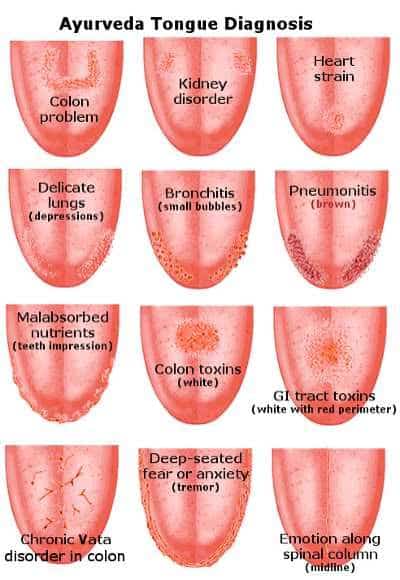Checking up on your health doesn’t have to be expensive and time-consuming. Of course, getting a full medical workup with lab tests and imaging is important if you need it, but for the average person who just wants to get a sense of how well she digested last night’s dinner or how well his body is handling the stress of working overtime, there’s a simple self-check that you can do in your own bathroom mirror. Just stick out your tongue.
Within a few seconds, it’s possible to get the inside scoop on what’s going on with your body just by looking at your tongue. And while it takes years of practice to be able to read tongues in a clinical setting like Doctors do, you can start checking in on your own body at home by looking for these three key signs:
1. Red Tip
The tip of the tongue corresponds to the “Heart” organ system in Traditional Chinese Medicine. The heart governs not only your physical heart but also the mind and emotions. Redness at the tip of the tongue indicates that there is too much “heat” in this system, and often correlates with symptoms like insomnia, nervousness, heart palpitations, and an unquiet mind.
If your tongue tip is red, it’s a sign that you need more cooling and calming practices in your life. Try incorporating meditation, yin yoga or progressive muscle relaxation into your daily routine.
2. Thick Coating
The coating of your tongue is said to be like the steam that rises from the digestive process. Healthy digestion “burns clean” and produces a light, white, evenly distributed coating. If the coating is thick, especially toward the back of the tongue, this is a signal that your digestion isn’t performing at peak efficiency.
Try adjusting your diet with the help of a practitioner, or adding herbs and spices to your food to support your digestion. A sudden change in the coating of your tongue can also be a sign that you’re fighting off an infection, like a cold or the flu.
3. Teeth Marks
Teeth marks on the sides of your tongue can happen for one of two reasons. Either you’re pushing your tongue forward against your teeth during the night, or your tongue itself is slightly swollen. If you grind your teeth, chances are good that you’re also pushing your tongue forward and creating teeth marks.
If this is you, make sure you’re getting enough exercise during the day, and do some self-massage of your hip and upper back muscles with a tennis ball before bed.
If you don’t grind your teeth, this sign often points to a pattern that we call Spleen Qi Deficiency in TCM. This pattern is an underlying source of sugar cravings, low energy, sluggish digestion, loose stools, mental rumination and weight gain. Try adding cinnamon and ginger to your food (or sipping these herbs in tea form) and make sure to get up and walk at least 100 steps after meals.
How to Read Your Tongue:
1. Avoid eating or drinking for at least 30 minutes beforehand. Also, don’t scrape your tongue before you read it!
2. Be in a source of natural light, if at all possible.
3. Stick your tongue out in the way that feels most natural. Look at your tongue for up to 15 seconds at a time; if you keep it out longer than that, the color of your tongue will start to change and this will distort your reading.
4. Look for these three signs:
- Red tongue tip
- Thick tongue coating
- Teeth marks on the sides of your tongue
5. Be kind to your tongue and to yourself. It’s very common for people to feel embarrassed about their tongues, but there’s no need to be hard on yourself. This is just a “printout” of the current state of your body, and being kind to and accepting of what you see on your tongue is a way to practice kindness and acceptance of your whole body and everything it does for you.
6. Follow up with a practitioner if you have any questions or concerns about signs you see on your tongue, and remember not to use tongue reading as a substitute for medical diagnosis.
Most importantly, take action on what you learn by looking at your tongue. Let your tongue reading inspire you to make the necessary shifts so that you can thrive. Then, enjoy watching your tongue change in response to your new healthy habits!
Tongue Diagnosis and Analysis
What does your tongue say about your health?
I once attended a Tongue Diagnosis seminar at Bastyr University given my a wonderful author, Giovanni Maciocia. I had read his book several years before that and had been looking at tongues (both human and animal) for years, but it seemed that there was SO much to know and try to understand that it seemed overwhelming.
Before examining the tongue for diagnosis, make sure the patient has not eaten pickles, cayenne pepper, curry and other hot things. They will temporarily turn the tongue red. It takes a few hours for the tongue to get its normal coat back after the person has scraped it as well. And smoking turns the coat yellow.
Ask what medications the patient is on because they affect tongue diagnosis.
- Antibiotics make the tongue peel within 2-3 days and this peeling is not replaced until2-3 weeks after the antibiotics are stopped.
- Asthma medications (bronchodilators) causes the tip of the tongue to redden.
- Diuretics cause the coating to disappear (yin deficiency). Years of diuretics causes the tongue to peel.
- Anti-inflammatory drugs (NSAID’s) causes the tongue to have red points and makes the body of the tongue thinner. Years of taking these drugs cause the tongue to peel.
- Anticancer drugs can cause the tongue to develop a thick brown to black dry coating.
- Steroids causes the tongue to become red and swollen.
A normal tongue is pink in color, medium thickness, no cracks, ulcers, no teeth marks and with a light white moist coat (with root) on it. It has a look of aliveness and is supple (not stiff). There is no movement (quivering, trembling, side-to-side motion, curling or shifting to one side.) A healthy tongue looks like a piece of freshly killed meat.
In general the tongue is divided into three regions called burners.
- The first third of the tongue (tip of the tongue) indicates what is happening in the heart and lungs. The sides of the tip represent the chest/breasts.
- The middle third of the tongue is related to the stomach and spleen.
- The back third of the tongue is related to the bladder, kidneys, small and large intestines.
- The liver and gall bladder areas are on the sides of the tongue.
- The chest/breasts areas is just behind the tip of the tongue but on the edge.
Tongue diagnosis and analysis should be performed systematically. Dr. Maciocia says that the color is the most important, then shape and coating come next. Moisture and vitality (called Shen) are also important.
Shen can also be seen in the eyes, the walk and the way the patient communicates (talks/barks/vocalizes) and is an important indicator on the ability to recover from imbalances.

Tongue Diagnosis: Color of the Tongue:
- Progression of Color: When a body shows dis-ease the tongue color (underneath the coating) turns from pink to pale, to red and then to purple.
- Purple tongues mean blood stasis.
- Red dots on the tongue are called points and they have a meaning wherever they are. In Asian and African people these red dots can look brown.
Tongue Diagnosis: Coating of the Tongue: (Coating is related to Stomach function.)
- A white coat corresponds to cold in the area of the body correlating to the tongue.
- A yellow coat is related to heat.
- A coating can be with “root” which means the coating cannot be scraped off and it looks like grass growing from the soil.
- A coating without root looks like it has been sprinkled on and can be scraped off.
- The thicker the coat, the more progressed the disease.
- Lack of a coat means that the digestion is not working correctly.
- The coating is slightly thicker on the back of the tongue.
When you look too far back you will see the circumvallate papillae. These have no significance in a tongue reading and beginner tongue readers often get alarmed when they see them (especially if they don’t know basic medical anatomy.)
Tongue Diagnosis: Shape of the Tongue:
- Thin tongues mean deficiency.
- Swollen tongues can mean lack of harmony in getting fluids processed and can involve the spleen, stomach, kidneys and heart. It can also be from to much alcohol or increased toxic buildup.
- Swollen edges can mean weak spleen.
- Swollen sides can mean liver challenges.
- Swollen tip can mean heart problems.
- Swelling between the tip and middle of tongue and mean lung problems, phlegm, chest or breast problems. Ulcers here can mean cancer of the breasts.
- Localized swellings involve the corresponding organ.
Tongue Diagnosis: Tongue Cracks:
- The deeper the crack the longer the dis-ease, imbalance or stronger the genetic weakness or tendency.
- Transverse cracks or cracks on the sides has to do with spleen challenges.
- Center cracks mean stomach/digestion problems.
- If the Center crack goes to the tip of the tongue it also involves the heart.
- Transverse cracks behind the tip indicate lung weakness.
- Teeth marks (I see this often) mean spleen deficiency.
Tongue Diagnosis: When the very tip of the tongue is red this means that there is a major emotional cause of whatever the rest of the tongue indicates as disease.
I didn’t know enough about Chinese medicine (or the language!) to be able to decipher how to treat the body once you figure out what is wrong with it. It seems there are hundreds of formulas and combinations of formulas and “exceptions” to rules and I couldn’t really understand what he was even saying at times. I guess I have my job cut out for me going through my herb books and figuring out which are heating, cooling, yin/yang herbs and finding the American names for the Chinese herbs. I’ve ordered formulas from herb companies before only to receive something I’d already had on my shelf! On second thought. . .it’s just easier to muscle test and ask the body what it really wants.
Overall, it’s all about finding what areas are stagnated, which need to be nourished, which are getting too much circulation or too little circulation, too much energy or too little, and how to balance out the body so that everything is in harmony. There are many ways to do this.
Source: https://www.mindbodygreen.com/0-17879/how-to-read-your-tongue-for-3-key-signs-of-health.html
Disclaimer: All information, data and material has been sourced from multiple authors and is for general information and educational purposes only and are not intended to replace the advice of your treating doctor.
The views and nutritional advice expressed are not intended to be a substitute for conventional medical service. If you have a severe medical condition or health concern, see your physician.





